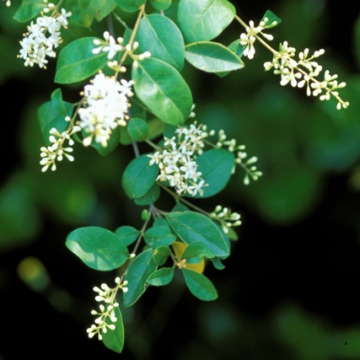- Home
- Page
Ligustrum Sinense / Small-Leaved Privet
Description:
A deciduous or semi-evergreen shrub growing to 3-6m high with dense, glossy foliage. Mid to dark green leaves, sometimes variegated, or yellow. Shoots are densely downy and leaves are hairy on the midrib beneath. Heavily scented white flowers in terminal clusters from October to February. Shiny black berries. The leaves and fruit are poisonous to humans and certain animals.




Distinguishing Characteristics
Chinese privet is an evergreen to semi-deciduous shrub or small tree that can grow to 16 feet high (or occasionally even taller). Plants are generally well-branched, with smooth bark that is gray to tan in color. The root system is shallow, but extensive, and frequently produces suckers. The branchlets are densely pubescent. The petioles (leaf stalks) and the leaf undersides are usually more sparsely pubescent, with the hairs sometimes restricted to the major veins on the undersides of mature leaves. Leaf arrangement is opposite to subopposite, with the leaves spaced at ½ to ¾ inch intervals on long, thin twigs. The leaves are typically two-ranked (held in a single plane), giving the branches a flattened appearance. The petioles are short (⅛ to ⅓ inch long). The leaf blades, which measure ¾ to 2 inches long, are ovate to elliptic in shape, with rounded to bluntly acute tips and entire or undulate margins. The small (⅙ inch long), white to off-white flowers are borne in 2 to 4 inch long, conical panicles at the branch tips and the leaf axils. The short-stalked flowers have two exserted (projecting beyond the petals) stamens, a cup-like green calyx bearing four small, pointed teeth and four petals that are fused into a short tube at the base. The flowers are odorous with a smell that is often described as disagreeable. The fruit are ⅕ inch long, blue-black drupes that are ellipsoidal to globose in shape and contain one to four seeds.
Where does this species come from?
China.
What is its invasive status in South Africa?
Existing legislation: CARA 2002 – Category 1 NEMBA – Category 1b in KwaZulu-Natal, Mpumalanga, Limpopo, Eastern and Western Cape, Gauteng and North West, 3 in Free State and Northern Cape.
Where in South Africa is it a problem?
KwaZulu-Natal, Mpumalanga, Eastern Cape and Gauteng Provinces.
How does it spread?
Seed dispersal.
Why is it a problem?
Competes with and has the potential to replace indigenous species. Poisonous. Indigenous birds could neglect the dispersal of indigenous plants as a consequence of their preference for the fruits of this alien species.
What does it look like?
General description: A deciduous or semi-evergreen shrub growing 3-6m high with glossy, dense foliage.
Leaves: Mid to dark green leaves.
Flowers: Heavily scented white flowers in terminal clusters appear from October to February.
Fruit/seeds: Shiny black berries in clusters.
Does the plant have any uses?
Ornament and hedging. Birds eat the fruits.
 Hey, need help? We are here
Hey, need help? We are here